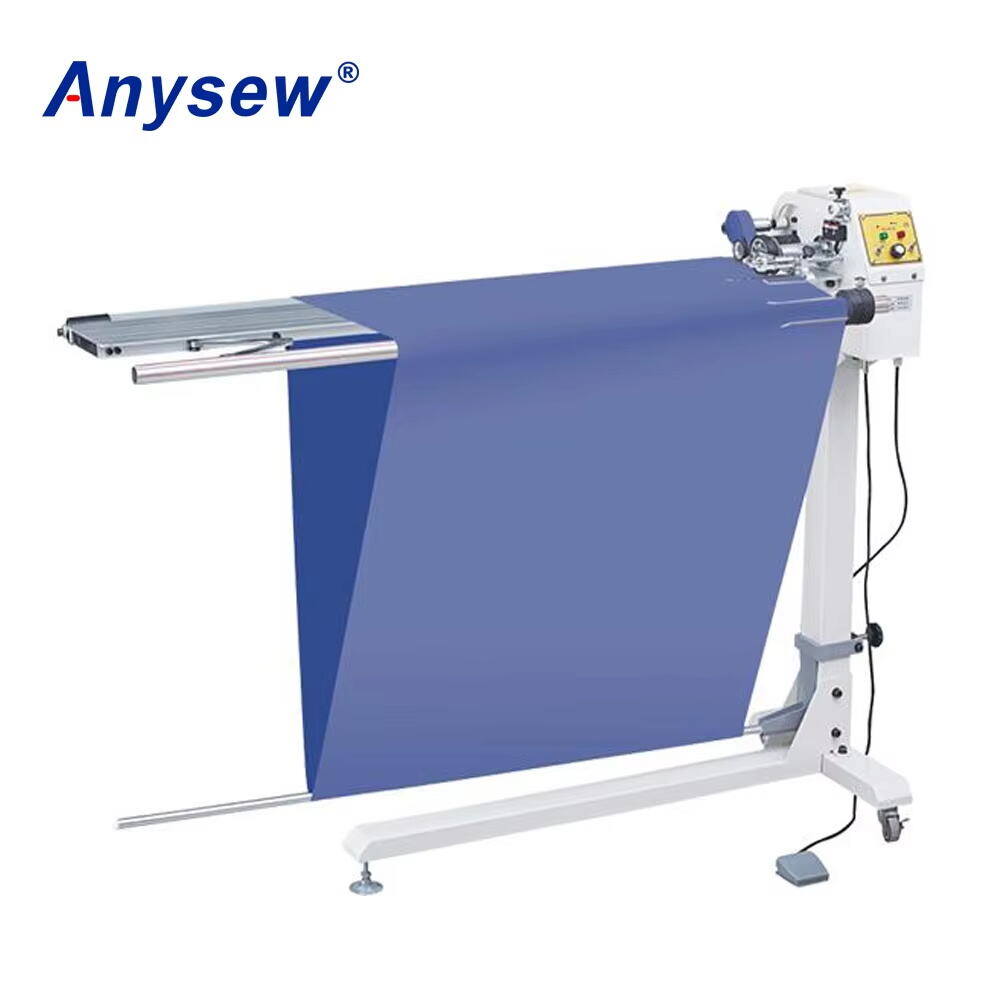Končni vodnik za izbiro popolnega stroja za rezanje blaga
Tehnologija strojev za rezanje tkanin je pomemben del sodobne proizvodnje oblačil, ki omogoča natančno in učinkovito rezanje tkanin za izpolnjevanje proizvodnih zahtev. Podjetje Hangzhou Anysew Garment Equipment Co., Ltd se specializira za načrtovanje in proizvodnjo industrijske opreme za oblačila, vključno s šivalnimi stroji, veznimi stroji, rezalnimi stroji ter naprednimi stroji za rezanje tkanin. Izbira najboljšega stroja za rezanje tkanin omogoča proizvajalcem optimizacijo delovnega procesa, zmanjšanje odpadkov tkanine in ohranjanje visoke kakovosti proizvodnje.
Rezalni stroji za tkanine od Hangzhou Anysew so zasnovani za natančnost, trdnost in brezhibno vključitev v drugo opremo za proizvodnjo oblačil. Z možnostmi prilagoditve in napredno avtomatizacijo lahko proizvajalci učinkovito obdelujejo velike naročila, hkrati pa ohranjajo dosledno natančnost rezanja.
Razumevanje rezalnih strojev za tkanine
Vrste strojev za rezanje tkanin
Rezalni stroji za tkanine vključujejo rezalnike s strmi nožem, rezalnike s krožnim nožem, laserske rezalne stroje in avtomatizirane CNC rezalnike za tkanine. Vsaka vrsta je primerna za določene tkanine in zahteve pri proizvodnji ter zagotavlja natančne reze in minimalne odpadke materiala.
Ključne značilnosti sodobnih rezalnih strojev za tkanine
Sodobni rezalni stroji za tkanine ponujajo nastavljivo hitrost in globino rezanja, programirljive vzorce rezanja, avtomatske sisteme za dovajanje in varnostne mehanizme. Te značilnosti pomagajo ohraniti dosledne rezultate in hkrati izboljšati učinkovitost proizvodnje.
Integracija s šivalno, veznarsko in zaključno opremo
Stroji za rezanje tkanin dopolnjujejo šivalne stroje, vezenje stroje in zaključno opremo. Ko so vzorci označeni in sloji nanizani, stroji za rezanje tkanin zagotavljajo natančne reze, potrebne za visokokakovostno oblačilo, s čimer poenostavijo proizvodne procese.
Možnosti prilagoditve za popoln stroj za rezanje tkanin
Nastavljivi parametri rezkanja
Različne tkanine zahtevajo specifične hitrosti rezanja, kote in globine noža. Prilagodljivi stroji za rezanje tkanin podjetja Hangzhou Anysew omogočajo proizvajalcem, da te parametre natančno prilagodijo, da zagotovijo popolne reze za bombaž, poliester, svilo ali mešane tkanine.
Programirljivi vzorci in avtomatizacija
Napredni stroji za rezanje tkanin imajo programirljive rezné vzorce in avtomatsko delovanje, ki zmanjšata ročno delo. Tovarne lahko prilagodijo zaporedja in gibanje noža, da optimizirajo rezanje za različne modele oblačil.
Možnosti rezanja več plasti
Nekateri stroji za rezanje tkanin lahko hkrati režejo več plasti tkanine. Prilagodljivo večplastno rezanje poveča učinkovitost proizvodnje in zmanjša odpad tkanine.
Varnost in trajnost
Hangzhou Anysew zagotavlja, da so stroji za rezanje tkanin izdelani z odpornimi okvirji, visokokakovostnimi rezili in varnostnimi funkcijami, kar zmanjšuje tveganje za operaterje in omogoča dolgotrajno delovanje v okoljih za masovno proizvodnjo.
Prednosti uporabe visokokakovostnega stroja za rezanje tkanin
Izboljšana natančnost rezanja
Stroji za rezanje tkanin zagotavljajo natančne oblike, čiste robove in minimalno deformacijo tkanine. Ta natančnost podpira enakomerno kakovost oblačil in zmanjša napake v nadaljnjih procesih šivanja in dokončanja.
Povečana proizvodna učinkovitost
Samodejne funkcije in programirljive lastnosti zmanjšajo ročno delo in pospešijo rezanje tkanine. Proizvajalci lahko učinkovito obdelujejo večje naročila, hkrati pa ohranjajo natančnost.
Zmanjšan odpad tkanine in stroški obratovanja
Stroji za rezanje tkanin z nizko porabo energije zmanjšujejo odpadke materiala, optimizirajo porabo energije in zmanjšujejo obratovalne stroške ter zagotavljajo višjo donosnost naložbe.
Prilagodljivost za različne vrste oblačil
Prilagodljivi stroji za rezanje tkanin se prilagodijo različnim tkaninam in slogom oblačil ter podpirajo proizvodnjo za hitro modno industrijo in proizvodnjo po naročilu.
Izbira najprimernejšega stroja za rezanje tkanin
Ocena proizvodnih potreb
Ocenite vrste tkanin, količino proizvodnje, zapletenost oblačil in zahteve glede kakovosti. Izbira stroja za rezanje tkanin, ki ustreza tem potrebam, zagotavlja učinkovito rezanje in maksimalizira donos.
Ocena lastnosti in zmogljivosti
Visoko kakovostni stroji morajo ponujati nastavljive parametre rezanja, programirljive vzorce, rezanje več plasti hkrati in trdno konstrukcijo. Modulne in avtomatizirane možnosti dodatno izboljšajo prilagodljivost delovnega toka.
Skladnost z obstoječim opremi
Poskrbite, da se stroji za rezanje tkanin brezhibno vključijo v šivanje, vezenje in zaključne postopke. Ustrezna integracija ohranja učinkovitost proizvodnje in zmanjšuje prostoj.
Održavanje in najboljše prakse
Redna vzdrževalna nega nožev in čiščenje
Redno brusjenje, čiščenje in pregledovanje nožev preprečuje napake pri rezanju in ohranja enakomerno kakovost med serijami.
Usposabljanje operaterjev in pravilna uporaba
Operaterji morajo slediti navodilom proizvajalca glede hitrosti noža, globine in delovanja. Pravilna uporaba zmanjša poškodbe tkanine in zagotavlja varnost.
Tehnološke nadgradnje in inovacije
Pametni stroji za rezanje tkanin z avtomatizacijo, CNC zmogljivostmi in energetsko učinkovitimi funkcijami dodatno izboljšajo proizvodno učinkovitost. Napredne funkcije, kot so povezljivost IoT in prediktivno vzdrževanje, pomagajo optimizirati sodobne tovarne za oblačila.
Pogosta vprašanja
Katere vrste strojev za rezanje tkanin se pogosto uporabljajo v proizvodnji oblačil
Stroji z ravnim nožem, krogleči noži, laserski rezalni stroji in CNC rezalniki tkanin se pogosto uporabljajo za učinkovito rezanje različnih tkanin.
Kako lahko proizvajalci zagotovijo dolgoročno zmogljivost strojev za rezanje tkanin
Redno vzdrževanje, brusjenje nožev, pregledovanje in pravilna uporaba v skladu z navodili proizvajalca zagotavljajo stabilno zmogljivost in podaljšajo življenjsko dobo strojev.
Ali lahko stroji za rezanje tkanin visoke kakovosti izboljšajo učinkovitost proizvodnje
Da, avtomatizirani in programirljivi stroji za rezanje tkanin zmanjšujejo ročni delo, pospešujejo proces rezanja in ohranjajo dosledno kakovost tkanine.
Kateri dejavniki naj bodo upoštevani pri izbiri stroja za rezanje tkanin
Upoštevajte vrste tkanin, obseg proizvodnje, zapletenost oblačil, potrebne funkcije, energetsko učinkovitost ter združljivost s trenutno šivalno, veznarsko in zaključno opremo.
Vsebina
- Končni vodnik za izbiro popolnega stroja za rezanje blaga
- Razumevanje rezalnih strojev za tkanine
- Možnosti prilagoditve za popoln stroj za rezanje tkanin
- Prednosti uporabe visokokakovostnega stroja za rezanje tkanin
- Izbira najprimernejšega stroja za rezanje tkanin
- Održavanje in najboljše prakse
- Pogosta vprašanja
-
Katere vrste strojev za rezanje tkanin se pogosto uporabljajo v proizvodnji oblačil
- Stroji z ravnim nožem, krogleči noži, laserski rezalni stroji in CNC rezalniki tkanin se pogosto uporabljajo za učinkovito rezanje različnih tkanin.
- Kako lahko proizvajalci zagotovijo dolgoročno zmogljivost strojev za rezanje tkanin
- Ali lahko stroji za rezanje tkanin visoke kakovosti izboljšajo učinkovitost proizvodnje
- Kateri dejavniki naj bodo upoštevani pri izbiri stroja za rezanje tkanin

